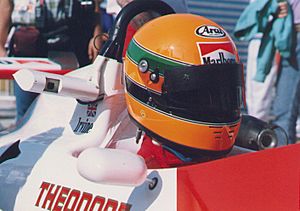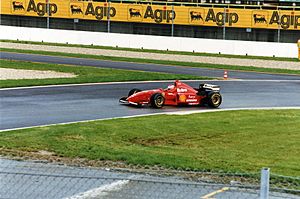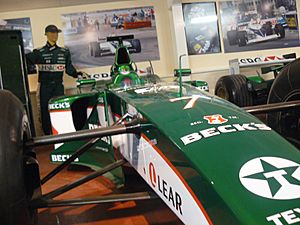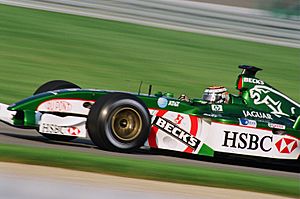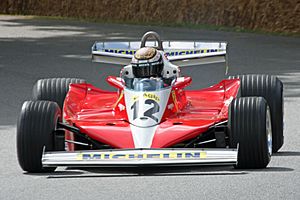Eddie Irvine facts for kids
Quick facts for kids
Eddie Irvine
|
|
|---|---|
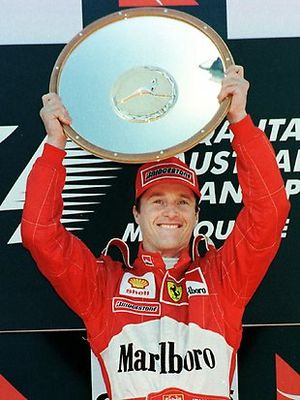
Irvine at the 1999 Australian Grand Prix
|
|
| Born |
Edmund Irvine Jr.
10 November 1965 Newtownards, County Down, Northern Ireland
|
| Children | 1 |
| Formula One World Championship career | |
| Nationality | |
| Active years | 1993–2002 |
| Teams | Jordan, Ferrari, Jaguar |
| Entries | 148 (145 starts) |
| Championships | 0 |
| Wins | 4 |
| Podiums | 26 |
| Career points | 191 |
| Pole positions | 0 |
| Fastest laps | 1 |
| First entry | 1993 Japanese Grand Prix |
| First win | 1999 Australian Grand Prix |
| Last win | 1999 Malaysian Grand Prix |
| Last entry | 2002 Japanese Grand Prix |
| 24 Hours of Le Mans career | |
| Years | 1992–1994 |
| Teams | Toyota, SARD |
| Best finish | 2nd (1994) |
| Class wins | 1 (1994) |
Edmund "Eddie" Irvine Jr. (born 10 November 1965) is a former racing driver from Northern Ireland. He raced in Formula One from 1993 to 2002. Irvine is best known for his time with the Ferrari team, where he nearly won the Formula One World Drivers' Championship in 1999. Over his ten-year career, he won four Grands Prix.
Irvine started racing at seventeen in Formula Ford. He quickly showed talent and moved up to bigger championships like Formula Three and Formula 3000. He joined Formula One in 1993 with the Jordan team. He became known for his exciting driving and bold personality.
His most successful year was 1999 with Ferrari. He won four races and finished second in the world championship, just two points behind Mika Häkkinen. After leaving Ferrari, he drove for Jaguar Racing and scored the team's first-ever podium finish. Irvine retired from racing at the end of the 2002 season.
Since retiring, Irvine has become a media personality and a successful property investor. He built up a large portfolio of properties during his racing career.
Contents
Early Life and Racing Beginnings
Eddie Irvine was born on November 10, 1965, in Newtownards, Northern Ireland. He grew up in the nearby village of Conlig. His love for motorsport started early, as his family often went to the British Grand Prix for holidays. His father, Edmund Sr., also raced cars for fun.
Irvine first wanted to race motorcycles, but his parents thought it was too dangerous. Instead, his father encouraged him to race cars. To pay for his hobby, Irvine worked for free at his father's scrapyard. He started racing in Formula Ford in 1983 and won his first race at Brands Hatch a year later. In 1987, he had a fantastic year, winning three different Formula Ford championships.
This success earned him a spot in the British Formula 3 championship for 1988. After that, he moved to the International Formula 3000 Championship. In 1990, driving for the Jordan team, he won a race in Germany and finished third in the championship. He then moved to Japan to race in their Formula 3000 series, where he continued to win races.
Formula One Career
Jordan (1993–1995)
Irvine got his big break in Formula One in 1993. He joined the Jordan team for the last two races of the season. In his very first race, the Japanese Grand Prix, he finished sixth and scored a championship point. He also had a famous run-in with the legendary driver Ayrton Senna. Irvine unlapped himself by passing Senna, which made Senna angry. After the race, the two had a heated argument.
In 1994, Irvine's season started with a big crash at the Brazilian Grand Prix. He was blamed for the accident and was banned for three races. When he returned, he scored points in Spain, Europe, and Japan. He finished the season 16th in the championship.
The 1995 season was a big step forward for Irvine. He scored his first-ever F1 podium with a third-place finish at the Canadian Grand Prix. His strong performances caught the eye of a top team. Before the season ended, Ferrari announced they had signed Irvine to be Michael Schumacher's teammate for 1996.
Ferrari (1996–1999)
A New Challenge
Joining Ferrari was a huge move for Irvine. In his first race for the team at the Australian Grand Prix, he finished on the podium in third place. However, the Ferrari car was not very reliable that year, and he had many retirements. He finished the season in 10th place.
In 1997, the car was better. Irvine scored his best-ever result with a second-place finish in Argentina. He also finished third in San Marino and Monaco. He ended the year seventh in the championship with 24 points.
The 1998 season was even better. Irvine stood on the podium eight times, including six third-place finishes and two second-place finishes. He was a strong support driver for his teammate Michael Schumacher, who was fighting for the championship. Irvine finished the year in fourth place overall.
The 1999 Championship Fight
The 1999 season was the most important of Irvine's career. He started the year by winning his very first Grand Prix in Australia. This put him in the lead of the World Championship.
A major turning point came at the British Grand Prix. His teammate, Michael Schumacher, crashed and broke his leg, forcing him to miss several races. Suddenly, Irvine became Ferrari's main driver and their hope for the championship.
Irvine rose to the challenge. He won the next two races in Austria and Germany. He was now in a close battle for the title with McLaren's Mika Häkkinen. When Schumacher returned for the final races, he helped Irvine by letting him win the Malaysian Grand Prix.
The championship was decided at the final race in Japan. Irvine needed a good result, but he struggled in qualifying and finished the race in third place. Häkkinen won the race and the championship. Irvine lost by just two points, but his efforts helped Ferrari win their first Constructors' Championship in 16 years.
Jaguar (2000–2002)
For the 2000 season, Irvine moved to the new Jaguar Racing team. The team was not as competitive as Ferrari, and Irvine had a difficult year. His best result was a fourth-place finish at the Monaco Grand Prix.
In 2001, Irvine achieved a major milestone for the team. He finished third at the Monaco Grand Prix, giving Jaguar its first-ever podium finish. It was a great moment for the new team.
Irvine's final season in Formula One was in 2002. He once again showed his skill by finishing on the podium in third place at the Italian Grand Prix. At the end of the year, Irvine retired from Formula One racing.
Life After Formula One
After retiring from racing, Irvine did not slow down. He had already become a millionaire by investing in property during his racing career. He owns around forty properties all over the world. In 2006, the Sunday Times Rich List named him the fifth richest person in Northern Ireland.
Irvine also became a media personality. In 2006, he hosted a TV show on Sky One called The Race, where celebrities learned to be racing drivers. He has also appeared in the comedy movie The Prince & Me, where he played himself.
He still owns Eddie Irvine Sports, a large sports facility in Bangor, Northern Ireland, near where he grew up. It offers activities like kart racing, paintball, and football.
Nationality and Identity
Being from Northern Ireland, Eddie Irvine has the right to identify as British, Irish, or both. He has said, "at the end of the day, I'm Irish." He raced with a British passport but held an Irish racing license.
This sometimes caused confusion at races. At some of his early podium ceremonies, the Irish Tricolour was flown by mistake. After this caused some issues, Irvine requested that a neutral shamrock flag be used instead. He also asked for the song "Londonderry Air" to be played if he won a race.
Personal Life
Irvine has a daughter named Zoe. He has said that the birth of his daughter was the best moment of his life.
During his career, he was known for his outspoken and fun-loving personality, which was different from many other drivers. He was often compared to the famous 1970s driver James Hunt. Because of his driving style, he earned the nicknames "Irv the Swerve" and later "Fast Eddie."
Images for kids
See also
 In Spanish: Eddie Irvine para niños
In Spanish: Eddie Irvine para niños


